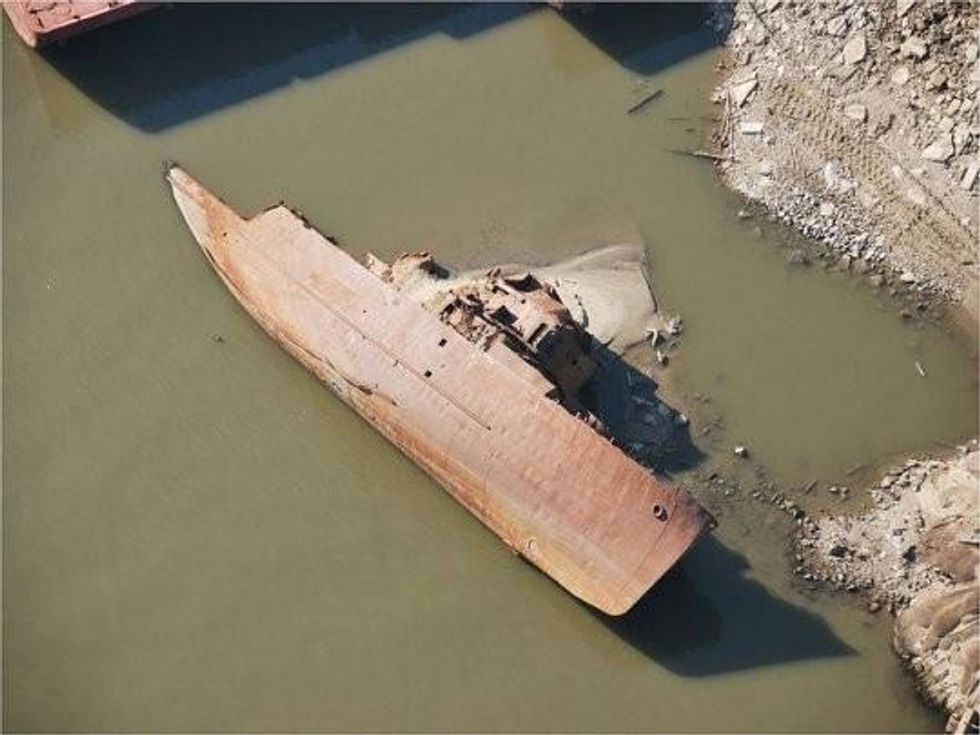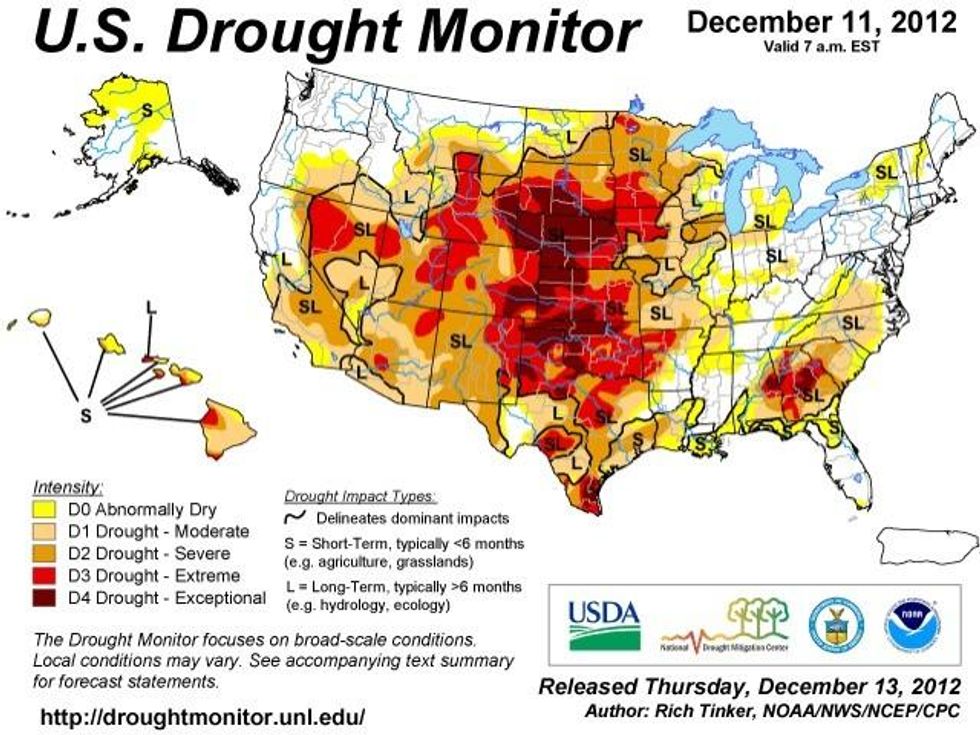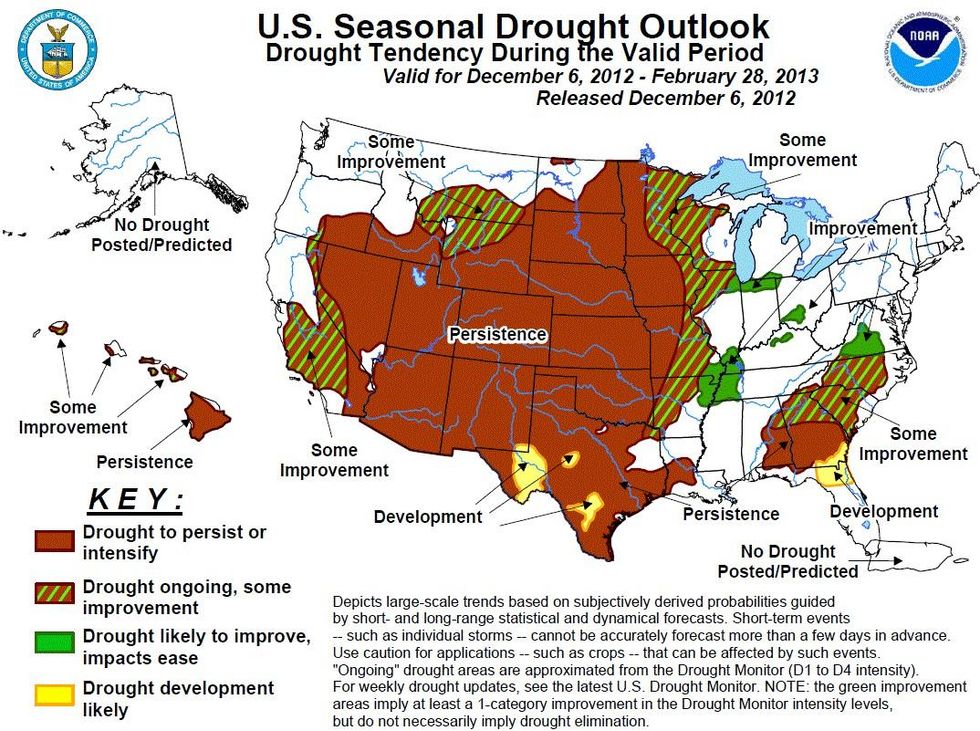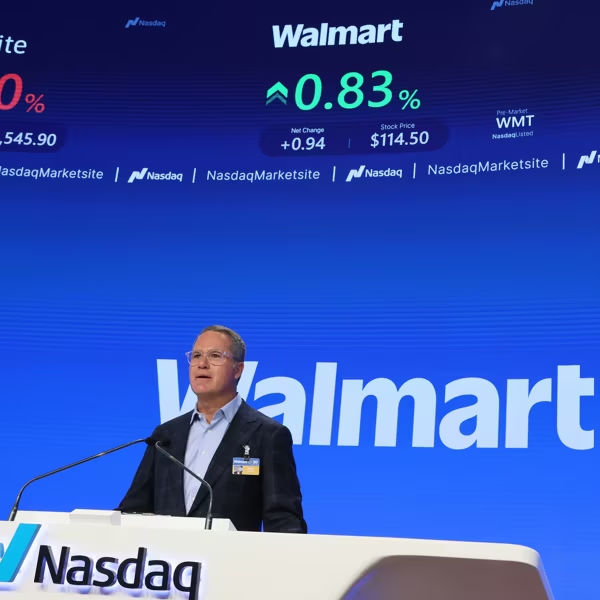How the Mighty (Mississippi) Has Fallen: Historic Drought Plagues US
Continuing drought forecast for already dessicated US as low river levels thwart traffic

As the worst drought in decades continues to plague the US, the Mississippi River is withering towards historic lows with widespread impacts for commerce.
The most recent Drought Monitor from the National Oceanic and Atmospheric Administration (NOAA) shows nearly 62% of the contiguous United States under moderate to exceptional drought.
There are 13 states that have 100% of their area in some level of drought, and three of those--Minnesota, Iowa and Missouri--are Mississippi River states.

The river is under a "low-water crisis," with record low levels on the horizon.
"All the ingredients for us getting to an all-time record low are certainly in place," Mark Fuchs, a hydrologist at the NOAA in St Louis, told the Guardian. "I would be very surprised if we didn't set a record this winter."
"I've been out here 46 years and I've never seen it this bad," Darrell Alford, a 66-year-old captain of a tow boat, told Bloomberg while navigating the Mississippi. "You're on edge all the time."
Bob Anderson, spokesperson for the Mississippi Valley division of the Army Corps of Engineers, adds: "We've never really had a drought quite so severe as this year."
The low levels are affecting commerce, as the river serves as a highway for transport of all manner of goods. The Guardian adds:
Shipping companies are hauling 15 barges at a time instead of a typical string of 25, because the bigger runs are too big for current operating conditions.
Barges are being sent off with lighter loads, making for more traffic, with more delays and back-ups. Stretches of the river are now reduced to one-way traffic. A long cold spell could make navigation even trickier: shallow, slow-moving water is more likely to get clogged up with ice. [...]
"There are so many issues at stake here," said George Foster, owner of JB Marine Services. "There is so much that moves on the river, not just coal and grain products, but you've got cement, steel for construction, chemicals for manufacturing plants, petroleum plants, heating oil. All those things move on the waterways, so if it shuts down you've got a huge stop of commerce."
The Guardian's Suzanne Goldenberg reports on the river in this video:
In an effort to keep traffic moving along the river KMOV St. Louis reports that "the Army Corps of Engineers will begin blasting the riverbed in an effort to keep the channel open for barge traffic."
In addition to being seen as a sign of further climate change-induced disasters to come, the drought and its effects on river traffic have real economic costs.
The Guardian reports that "about $7bn in vital commodities typically moves on the river at this time of year - including grain, coal, heating oil, and cement." And Weather Underground co-founder Jeff Masters wrote in November:
Sandy's damages of perhaps $50 billion will likely be overshadowed by the huge costs of the great drought of 2012. While it will be several months before the costs of America's worst drought since 1954 are known, the 2012 drought is expected to cut America's GDP by 0.5 - 1 percentage points, said Deutsche Bank Securities this week. "If the U.S. were growing at 4 percent, it wouldn't be as big an issue, but at 2 percent, it's noticed," said Joseph LaVorgna, the chief U.S. economist at Deutsche. Since the U.S. GDP is approximately $15 trillion, the drought of 2012 represents a $75 - $150 billion hit to the U.S. economy. This is in the same range as the estimate of $77 billion in costs for the drought, made by Purdue University economist Chris Hurt in August.
The hope of the drought and its effects ending soon is bleak. The NOAA foresees "drought conditions lingering or intensifying over much of the central and western United States."

An Urgent Message From Our Co-Founder
Dear Common Dreams reader, The U.S. is on a fast track to authoritarianism like nothing I've ever seen. Meanwhile, corporate news outlets are utterly capitulating to Trump, twisting their coverage to avoid drawing his ire while lining up to stuff cash in his pockets. That's why I believe that Common Dreams is doing the best and most consequential reporting that we've ever done. Our small but mighty team is a progressive reporting powerhouse, covering the news every day that the corporate media never will. Our mission has always been simple: To inform. To inspire. And to ignite change for the common good. Now here's the key piece that I want all our readers to understand: None of this would be possible without your financial support. That's not just some fundraising cliche. It's the absolute and literal truth. We don't accept corporate advertising and never will. We don't have a paywall because we don't think people should be blocked from critical news based on their ability to pay. Everything we do is funded by the donations of readers like you. Will you donate now to help power the nonprofit, independent reporting of Common Dreams? Thank you for being a vital member of our community. Together, we can keep independent journalism alive when it’s needed most. - Craig Brown, Co-founder |

As the worst drought in decades continues to plague the US, the Mississippi River is withering towards historic lows with widespread impacts for commerce.
The most recent Drought Monitor from the National Oceanic and Atmospheric Administration (NOAA) shows nearly 62% of the contiguous United States under moderate to exceptional drought.
There are 13 states that have 100% of their area in some level of drought, and three of those--Minnesota, Iowa and Missouri--are Mississippi River states.

The river is under a "low-water crisis," with record low levels on the horizon.
"All the ingredients for us getting to an all-time record low are certainly in place," Mark Fuchs, a hydrologist at the NOAA in St Louis, told the Guardian. "I would be very surprised if we didn't set a record this winter."
"I've been out here 46 years and I've never seen it this bad," Darrell Alford, a 66-year-old captain of a tow boat, told Bloomberg while navigating the Mississippi. "You're on edge all the time."
Bob Anderson, spokesperson for the Mississippi Valley division of the Army Corps of Engineers, adds: "We've never really had a drought quite so severe as this year."
The low levels are affecting commerce, as the river serves as a highway for transport of all manner of goods. The Guardian adds:
Shipping companies are hauling 15 barges at a time instead of a typical string of 25, because the bigger runs are too big for current operating conditions.
Barges are being sent off with lighter loads, making for more traffic, with more delays and back-ups. Stretches of the river are now reduced to one-way traffic. A long cold spell could make navigation even trickier: shallow, slow-moving water is more likely to get clogged up with ice. [...]
"There are so many issues at stake here," said George Foster, owner of JB Marine Services. "There is so much that moves on the river, not just coal and grain products, but you've got cement, steel for construction, chemicals for manufacturing plants, petroleum plants, heating oil. All those things move on the waterways, so if it shuts down you've got a huge stop of commerce."
The Guardian's Suzanne Goldenberg reports on the river in this video:
In an effort to keep traffic moving along the river KMOV St. Louis reports that "the Army Corps of Engineers will begin blasting the riverbed in an effort to keep the channel open for barge traffic."
In addition to being seen as a sign of further climate change-induced disasters to come, the drought and its effects on river traffic have real economic costs.
The Guardian reports that "about $7bn in vital commodities typically moves on the river at this time of year - including grain, coal, heating oil, and cement." And Weather Underground co-founder Jeff Masters wrote in November:
Sandy's damages of perhaps $50 billion will likely be overshadowed by the huge costs of the great drought of 2012. While it will be several months before the costs of America's worst drought since 1954 are known, the 2012 drought is expected to cut America's GDP by 0.5 - 1 percentage points, said Deutsche Bank Securities this week. "If the U.S. were growing at 4 percent, it wouldn't be as big an issue, but at 2 percent, it's noticed," said Joseph LaVorgna, the chief U.S. economist at Deutsche. Since the U.S. GDP is approximately $15 trillion, the drought of 2012 represents a $75 - $150 billion hit to the U.S. economy. This is in the same range as the estimate of $77 billion in costs for the drought, made by Purdue University economist Chris Hurt in August.
The hope of the drought and its effects ending soon is bleak. The NOAA foresees "drought conditions lingering or intensifying over much of the central and western United States."


As the worst drought in decades continues to plague the US, the Mississippi River is withering towards historic lows with widespread impacts for commerce.
The most recent Drought Monitor from the National Oceanic and Atmospheric Administration (NOAA) shows nearly 62% of the contiguous United States under moderate to exceptional drought.
There are 13 states that have 100% of their area in some level of drought, and three of those--Minnesota, Iowa and Missouri--are Mississippi River states.

The river is under a "low-water crisis," with record low levels on the horizon.
"All the ingredients for us getting to an all-time record low are certainly in place," Mark Fuchs, a hydrologist at the NOAA in St Louis, told the Guardian. "I would be very surprised if we didn't set a record this winter."
"I've been out here 46 years and I've never seen it this bad," Darrell Alford, a 66-year-old captain of a tow boat, told Bloomberg while navigating the Mississippi. "You're on edge all the time."
Bob Anderson, spokesperson for the Mississippi Valley division of the Army Corps of Engineers, adds: "We've never really had a drought quite so severe as this year."
The low levels are affecting commerce, as the river serves as a highway for transport of all manner of goods. The Guardian adds:
Shipping companies are hauling 15 barges at a time instead of a typical string of 25, because the bigger runs are too big for current operating conditions.
Barges are being sent off with lighter loads, making for more traffic, with more delays and back-ups. Stretches of the river are now reduced to one-way traffic. A long cold spell could make navigation even trickier: shallow, slow-moving water is more likely to get clogged up with ice. [...]
"There are so many issues at stake here," said George Foster, owner of JB Marine Services. "There is so much that moves on the river, not just coal and grain products, but you've got cement, steel for construction, chemicals for manufacturing plants, petroleum plants, heating oil. All those things move on the waterways, so if it shuts down you've got a huge stop of commerce."
The Guardian's Suzanne Goldenberg reports on the river in this video:
In an effort to keep traffic moving along the river KMOV St. Louis reports that "the Army Corps of Engineers will begin blasting the riverbed in an effort to keep the channel open for barge traffic."
In addition to being seen as a sign of further climate change-induced disasters to come, the drought and its effects on river traffic have real economic costs.
The Guardian reports that "about $7bn in vital commodities typically moves on the river at this time of year - including grain, coal, heating oil, and cement." And Weather Underground co-founder Jeff Masters wrote in November:
Sandy's damages of perhaps $50 billion will likely be overshadowed by the huge costs of the great drought of 2012. While it will be several months before the costs of America's worst drought since 1954 are known, the 2012 drought is expected to cut America's GDP by 0.5 - 1 percentage points, said Deutsche Bank Securities this week. "If the U.S. were growing at 4 percent, it wouldn't be as big an issue, but at 2 percent, it's noticed," said Joseph LaVorgna, the chief U.S. economist at Deutsche. Since the U.S. GDP is approximately $15 trillion, the drought of 2012 represents a $75 - $150 billion hit to the U.S. economy. This is in the same range as the estimate of $77 billion in costs for the drought, made by Purdue University economist Chris Hurt in August.
The hope of the drought and its effects ending soon is bleak. The NOAA foresees "drought conditions lingering or intensifying over much of the central and western United States."


